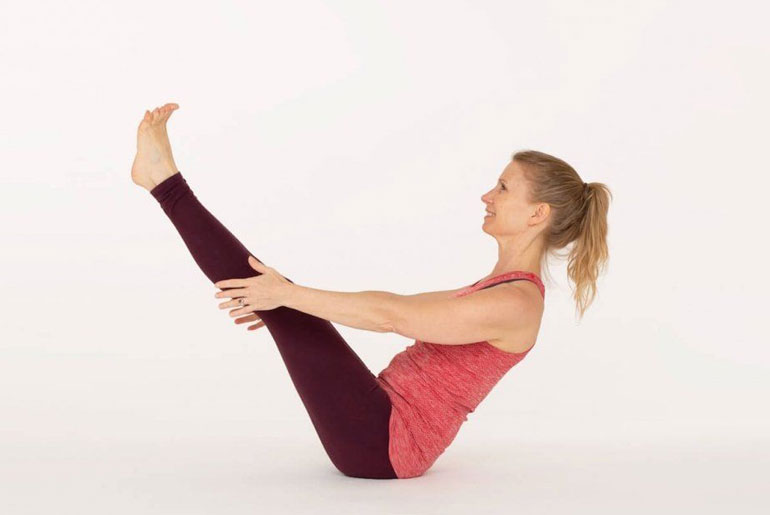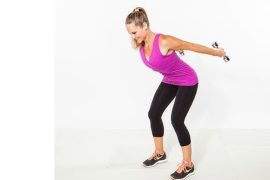Your core includes not just your abdominal muscles but also your hips, pelvis, and lower back, all of which play a crucial role in everyday movements like bending, lifting, and reaching. Strengthening these muscles enhances stability and ease in performing daily tasks. Core-focused exercises such as crunches and planks are effective, while yoga, particularly Boat Pose (Naukasana), further builds core strength. Interestingly, there are multiple variations of this pose that can be practiced to engage different muscle groups and improve overall stability and endurance.
Yes, yoga is excellent for building a strong core! Many yoga poses engage deep core muscles, improving stability, balance, and posture. Regular practice can strengthen not only the rectus abdominis (your “six-pack” muscles) but also deeper stabilizing muscles like the transverse abdominis, obliques, and pelvic floor.
Yoga for a strong core:
Here are some yoga poses that effectively target the core:
- Boat Pose (Navasana): Strengthens the abs, hip flexors, and spine.
- Plank Pose (Phalakasana): Engages the entire core, shoulders, and back.
- Side Plank (Vasisthasana): Works the obliques and improves lateral stability.
- Bridge Pose (Setu Bandhasana): Activates the glutes, lower back, and pelvic floor.
- Chair Pose (Utkatasana): Engages the core while improving lower body strength.
- Crow Pose (Bakasana): Strengthens the core, arms, and wrists while improving balance.
- Warrior III (Virabhadrasana III): Enhances core stability and balance.
A strong core not only supports yoga practice but also prevents back pain, improves mobility, and enhances athletic performance. Would you like a specific yoga sequence for core strengthening?
Regular yoga practice can significantly improve core strength, as supported by a 2014 study in the Complementary Therapies in Medicine journal. However, not all yoga poses equally engage the core. Boat Pose (Naukasana) is one of the most effective asanas for core activation. A 2017 study in the International Journal of Yoga found that this pose effectively engages core muscles, including the rectus abdominis. Experts emphasize that strengthening the core through Boat Pose enhances functional fitness, reduces the risk of injury, and improves athletic performance.
Boat Pose variations:
Boat Pose (Naukasana) is a seated yoga pose that mimics the shape of a boat, requiring balance and core engagement. In this asana, you sit on the mat with your legs extended, forming a V-shape with your body. It primarily targets core muscles, including the abdominals, while also engaging the lower back and hip flexors. The arms are usually extended forward, parallel to the ground, and the torso remains lifted and engaged, enhancing stability and strength.
Step-by-step guide to Boat Pose:
- Start by sitting on the mat with your legs straight in front of you.
- Lean back slightly while keeping your spine elongated and chest open.
- Lift your legs off the ground, keeping them bent at first, then slowly straighten them if you’re comfortable.
- Engage your core to help stabilize the posture, balancing on your sit bones.
- Extend your arms forward, parallel to the floor with palms facing each other, to help with balance.
- Hold for several breaths, focusing on maintaining a strong core and steady breathing.
To release, gently lower your feet and return to the seated position, avoiding any jerky movements.
For added challenge, you can try variations like holding the pose longer or attempting to straighten your legs and lean back further as you progress. How are you finding the pose so far?
Boat Pose Variations & Their Benefits
1. Half Boat Pose
- How to do it: Begin in Boat Pose, then lower your back halfway down while keeping your legs extended. Hold the position with your lower back off the ground.
- Benefits: Builds endurance and strengthens the rectus abdominis and hip flexors.
2. Low Boat Pose
- How to do it: From Boat Pose, lower your upper body and legs toward the floor while keeping them a few inches above the ground. Keep your arms parallel to the floor.
- Benefits: Strengthens lower abs, hip flexors, and stabilizing muscles while improving endurance.
3. Extended Boat Pose
- How to do it: From Naukasana, extend your arms overhead, creating a long line from fingertips to toes while maintaining the V-shape.
- Benefits: Enhances full-body coordination, core engagement, and balance.
4. Twisting Boat Pose
- How to do it: In Boat Pose, clasp your hands together and twist your torso to one side, then to the other, engaging the obliques.
- Benefits: Strengthens the obliques, enhancing rotational core strength and spine flexibility.
5. Boat Pose with Toe Taps
- How to do it: Lower one leg at a time to tap the floor while maintaining the Boat Pose position.
- Benefits: Improves lower core activation, control, and coordination.
6. Boat Pose with Leg Lifts
- How to do it: From Naukasana, lower your legs toward the floor without touching, then lift them back up.
- Benefits: Strengthens lower abdominals and hip flexors while enhancing control.
7. Boat Pose with One Leg Extended
- How to do it: Keep one leg bent with the foot on the ground while extending the other leg. Switch sides after a few breaths.
- Benefits: Helps build balance and unilateral core strength.
8. Boat Pose with Bent Knees
- How to do it: Maintain the Boat Pose but with bent knees, keeping shins parallel to the floor.
- Benefits: Great for beginners to develop core strength while reducing lower back strain.
9. Boat Pose to Low Boat Pose Transitions
- How to do it: Alternate between Boat Pose and Low Boat Pose in a slow, controlled manner.
- Benefits: Improves core endurance, stability, and dynamic strength.
10. Boat Pose with Block
- How to do it: Hold a yoga block between your hands in Boat Pose. Lift it overhead or twist side to side.
- Benefits: Adds resistance training, increasing core strength and shoulder engagement.
11. Boat Pose on Forearms
- How to do it: Support your upper body on your forearms while keeping your legs lifted.
- Benefits: Reduces strain on the lower back while still engaging the core.
12. Revolved Boat with Straight Legs
- How to do it: Maintain an upright torso, twist to one side, and hold your toes with the opposite hand.
- Benefits: Improves spinal flexibility, balance, and oblique strength.
13. Split Boat Pose
- How to do it: Start in the basic Boat Pose and then spread your legs apart in a split position.
- Benefits: Strengthens inner thighs, hip flexors, and deep core muscles.
14. Compass Boat Pose
- How to do it: Keep one leg at 30 degrees and the other at 90 degrees, holding the raised leg with the opposite hand.
- Benefits: Increases hip flexibility and oblique engagement.
15. Side Boat Pose
- How to do it: Lie on your side and lift both legs and arms up.
- Benefits: Activates obliques and deep core stabilizers, enhancing lateral strength.
Common Mistakes to Avoid in Boat Pose Variations
- Rounding Your Back: Maintain a straight spine to avoid lower back strain.
- Holding Your Breath: Breathe steadily to maintain focus and muscle endurance.
- Straining Your Neck: Keep the neck in line with the spine to avoid tension.
- Incorrect Leg Placement: Keep legs straight and together unless specified otherwise.
Why Practice Boat Pose Variations?
- Strengthens the entire core (abs, obliques, pelvic floor, back, glutes, and hip flexors)
- Improves balance, flexibility, and endurance
- Enhances posture and spinal health
- Helps with injury prevention and functional movement
Boat Pose variations are beginner-friendly and effective for building core strength. However, those with lower back pain should avoid them, as they may worsen discomfort. Experts also advise pregnant women to refrain from practicing Boat Pose variations, as they can put excessive strain on the abdomen. It’s essential to listen to your body and consult a professional before attempting these poses, especially if you have any underlying health concerns.
Disclaimer:
The information contained in this article is for educational and informational purposes only and is not intended as a health advice. We would ask you to consult a qualified professional or medical expert to gain additional knowledge before you choose to consume any product or perform any exercise.








